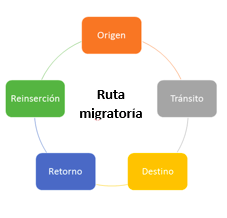
A wake-up call to protect migrant children
18 de December de 2016
Share
Children and adolescents on the migration route must work and are exposed to the worst forms of child labor.
Migration is a right, and a phenomenon that impacts the development of countries and the population, culture, cross-border relations, security, among others; For this reason, within the framework of International Migrants Day, we call for reflection on the reality of thousands of children and adolescents who, alone or with their families, are looking for better opportunities or a secure future. Migrating is not negative, however, many minors are forced to leave their cities of origin irregularly and in dangerous conditions, exposing themselves to the worst forms of child labor and deepening their situation of vulnerability.
| The main reasons expressed by children and adolescents for migrating are: to improve living conditions, family reunification and having received threats in their places of origin. |
In recent years, the number of migrants, including minors, has increased as a result of violence and social insecurity and non-inclusive economic growth. In the region, for example, since 2007 the unaccompanied Central American migrant child population has increased, especially from the countries of the northern triangle (Guatemala, Honduras and El Salvador) to Mexico and the United States; even in 2014 a humanitarian emergency was declared in the area, and there is evidence that the trend is towards increasing numbers.
This is a complex reality to face; The information available on the migrant child population is still scarce, much of it comes from children and adolescents who were intervened in some part of the migratory route or returned, however, many cross the borders and the authorities are unable to follow up respective.
The conditions in which minors migrate are, for the most part, precarious and risky, to this is added that in many cases, they do so without the company of their parents or an adult who supports, guides and protects them. during the route. Consequently, they are more exposed to being victims of criminal practices in the countries of transit or destination, they are forced to work during the trip in order to survive; in general, in jobs that threaten their health and integrity, take them away from educational opportunities, social protection, keep them anonymous and reduce the chances that they will find a decent job.

| Main dangers on the migration route:
|
Consequently, it is a priority to promote spaces for discussion and generate knowledge that helps to understand the problem, formulate policy recommendations and create proposals for timely articulated action for the protection of migrant children, especially those of permitted working age (among the 14 and 18 years of age) and that are not considered within public policies. The key is to generate new mechanisms for the prevention of child labor and protection for children and adolescents who migrate irregularly.
Materials to share:
- Watch the video on migrant children produced by the Regional Initiative at: https://www.youtube.com/watch?v=S1QSkolETMI
- Find different informational resources in the toolbox on migration, childhood and adolescence at: http://herramdamientos.iniciativa2025alc.org/
Comments
.jpeg)
Sumando esfuerzos para que América Latina y el Caribe sea una región libre de tr...
21 de June de 2024
En conmemoración del X aniversario de la Iniciativa Regional y el 25 aniversario del Convenio 182 de la OIT, se llevó a cabo un seminario de dos días...

Una década de lucha contra el trabajo infantil: Países de América Latina y el Ca...
12 de June de 2024
la Iniciativa Regional cumple 10 años de trayectoria, y para iniciar la conmemoración de este X Aniversario, sus integrantes han co-creado un mural e...
.png)
Barbados reafirma su compromiso tripartito para la erradicación del Trabajo Infa...
25 de April de 2024
El desarrollo de acciones de prevención y erradicación del trabajo infantil es una prioridad para el gobierno, organizaciones de empleadores y de trab...
.png)
The Regional Initiative for Latin America and the Caribbean Free of Child Labour...
01 de April de 2024
The Regional Initiative Latin America and the Caribbean Free of Child Labour deeply regrets the passing of Rumiko Tanaka, who, from the labour sector,...

Red de Puntos focales reafirma compromiso para impulsar la erradicación del trab...
07 de February de 2024
Los Puntos Focales de la Iniciativa Regional América Latina y el Caribe Libre de Trabajo Infantil, se ratificó el compromiso de acelerar las acciones...
